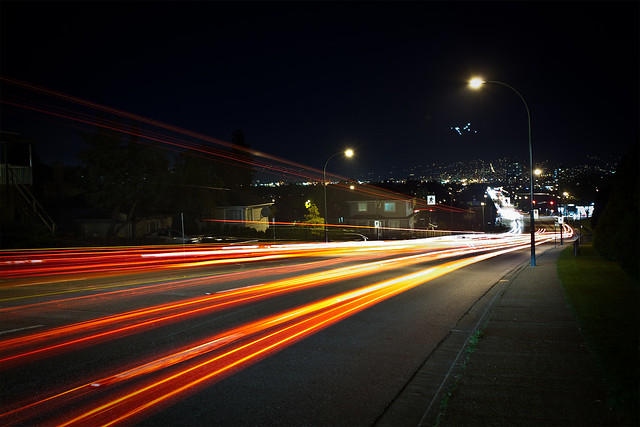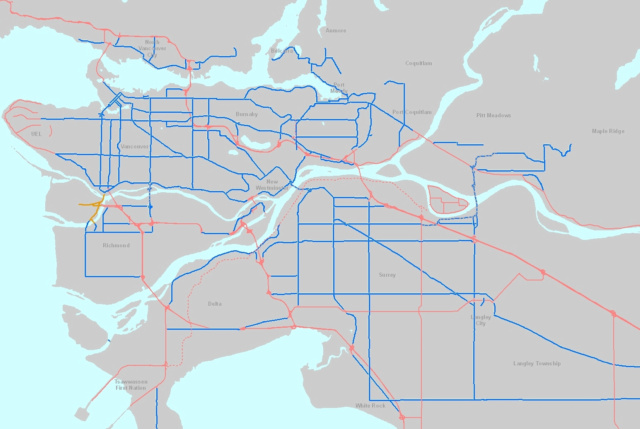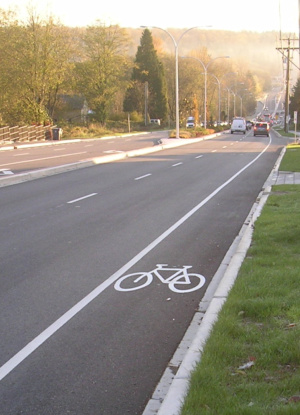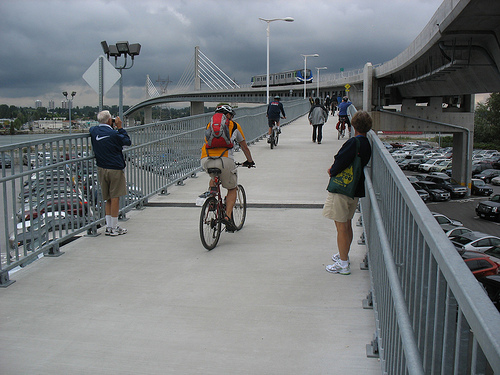TransLink 101: Managing major roads and bridges in Metro Vancouver
TransLink 101: Managing major roads and bridges in Metro Vancouver
For February 2013, we’re going back to basics with TransLink 101—a series of posts explaining TransLink and its work!

When most people think of TransLink, they immediately think of our transit services. But while transit is at the heart of our mandate, TransLink is also responsible for roads and bridges throughout the region, particularly corridors that connect communities and are critical for the movement of both people and goods.
So if you drive in Metro Vancouver, then you probably use roads that TransLink pays municipalities to operate and maintain! Running these roads, bridges, and transit helps TransLink fulfill its job to plan for regional transportation needs as a whole.
The Major Road Network (MRN)

TransLink has responsibility for what is called the Major Road Network (MRN), over 2,300 lane kilometres of major arterial roads that connect the cities of our service region. Lane kilometre is a measure of vehicle travel lanes – a one-kilometre long road that has four travel lanes has four lane kilometres of MRN.
Roads that are part of the MRN provide access across municipal boundaries to regional activity centres (e.g. universities, schools, business centres) and carry a high volume of traffic and vehicles that are going longer distances. Roads on the MRN may also carry a high volume of buses and trucks.
If you travel around Metro Vancouver, many of the roads that are part of the MRN will be familiar. For example:
- Knight Street
- Kingsway
- Broadway
- Lougheed Highway
- Royal Avenue
- Fraser Highway
- King George Boulevard
- No 2 Road
- Steveston Highway
- Old Dewdney Trunk Road
- Marine Drive and Marine Way
- Marine Drive (North Shore)
These are just some of the roads in the network, but most of the others are equally recognizable. Take a close look at the map to see if any of the roads you take – by bus or car – are part of the MRN. Chances are good that they are.
What does TransLink do for major roads?
Every year TransLink provides funding to municipalities to operate, maintain and rehabilitate these roads. The specific amount each municipality receives is linked to the number of lane kilometres of MRN it has. The total amount varies from year to year, but in 2013 TransLink is putting $44 million toward this work.
The funding allocated toward the municipalities is earmarked for operations, maintenance and rehabilitation. The list of what this includes is varied, but includes fixing potholes and cracks on the road; improving pavement; maintaining streetlights, signals and signs; maintaining sidewalks; and removing snow. TransLink provides the funding, but each municipality identifies and completes the work needed.
What about upgrades to major roads?

TransLink also funds upgrade projects for the major roads, and shares the cost of these with municipalities and other regional partners. Some of the projects are large such as Fraser Highway widening (Surrey and Langley), the Low Level Road Project (North Vancouver), the Coast Meridian Overpass (Port Coquitlam) and the 204 Street Overpass (Langley).
TransLink also helps fund a lot of smaller projects that have a significant day-to-day impact on our roads. These include things like turning bays, geometric improvements, signals for traffic control, or sidewalk widening.
I live in East Vancouver near Knight Street, which is part of the major road network (lots of cars, trucks and buses!). A few years ago, left-turn bays were put in at the intersection of East 33rd and Knight Streets. Traffic flows better through the intersection now, which benefits me both as a driver and as a transit user. I didn’t know it at the time, but the project was funded in part by TransLink. It’s a good example of the type of road projects TransLink helps fund.
What does TransLink do for bridges?

In addition to the major road network, TransLink also owns and has specific responsibility for operating several bridges. We aim to keep all these bridges safe and in good repair.
- Golden Ears Bridge (including Golden Ears Way from 176th Street in Surrey to 210th in Maple Ridge)
- Pattullo Bridge
- Knight Street Bridge
- Westham Island Bridge
- Canada Line pedestrian and bike bridge
TransLink: not just transit after all
Having responsibility for major roads and bridges helps TransLink fulfill its mandate to plan for regional transportation needs. Our roads and bridges connect cities across the region so it’s important for TransLink to provide a consistent and equitable level of funding that helps ensure significant corridors can effectively move both goods and people. The roads and bridges part of TransLink’s mandate also supports our role as a transit service provider, because the bus service we provide can only be as good as the roads the service runs on.
This is part of our special TransLink 101 series. If you have any questions, please share them in the comments!
Author: Tina Robinson







Just wondering…. what is the life expantancy of the Knight Bridge. I’ve heard the Georgia Viaduct is reaching end of life. But what about the life of the Knight Bridge? Is there someone that can be done with the Marine drive onramp that causes congestion and major accidents with all the traffic lanes merging?
typo….
someone := something
If Translink is responsible for these roads and bridges, why not make them more transit friendly/oriented? Worried about congestion, then why not make the road only easily passable by transit, commercial vehicles and emergency vehicles. Strategically placed park-n-rides with links to rapid transit and buses will make the roads better for everyone.
Why are TransLink roads built or maintained to ‘city’ standards? The thing I notice most about new and existing TransLink managed roads are raised curbs and lower speed limits than what should be appropriate for a given area.
Golden Ears Way is a prime example of that. Raised curbs and 60km/h on what could have easily been signed as 80km/h from 192nd Street. There are as many as five different speed zones as you cross the Golden Ears Bridge. For example, coming up 200th onto 201st, and Golden Ears Way you have the following: 60-50-80-70-60. Why are the speed limits on this stretch of road so inconsistent? Why not just 60-90?
There’s a few others I can think of, but Golden Ears Way is the most glaring.
Simply put, it feels like TransLink “doesn’t do highways”. Roads built under provincial jurisdiction don’t usually have this problem. If TransLink is unable or unwilling to properly build highways, why does it have responsibility for these corridors?
[…] are our roads and bridges, which make up eight per cent of expenditures; administration at four per cent, which includes […]
[…] responsible for in the region. For the basics on TransLink’s roads and bridges, check out the Managing major roads and bridges in Metro Vancouver post from our TransLink 101 […]
[…] responsible for in the region. For the basics on TransLink’s roads and bridges, check out the Managing major roads and bridges in Metro Vancouver post from our TransLink 101 series. Check out the roads and bridges series so […]
[…] responsible for in the region. For the basics on TransLink’s roads and bridges, check out the Managing major roads and bridges in Metro Vancouver post from our TransLink 101 series. Check out the roads and bridges series to read the other […]
[…] responsible for in the region. For the basics on TransLink’s roads and bridges, check out the Managing major roads and bridges in Metro Vancouver post from our TransLink 101 series and check out the roads and bridges series to read the other […]